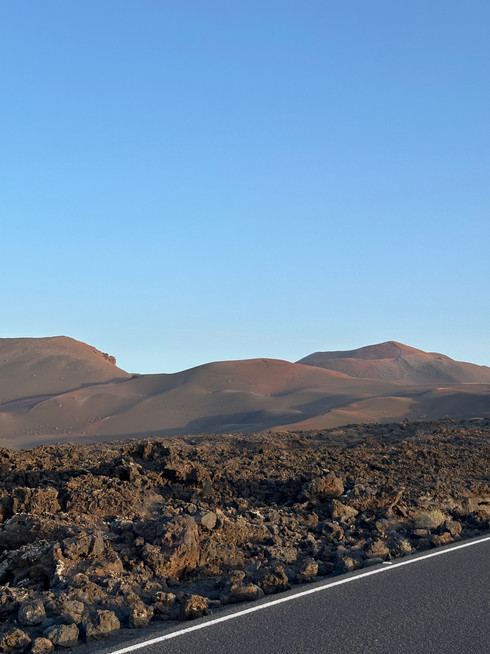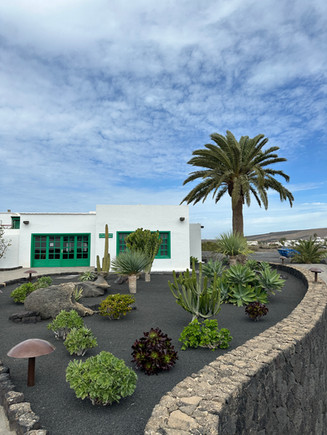Lanzarote – The most beautiful Canary Island: Top 10 of my favorite places + map!
- Julian

- Jun 30
- 10 min read
If there's one island I've underestimated, it's definitely Lanzarote. I spent a few days on this beautiful volcanic island in February 2024. I arrived here without a specific plan and was always amazed by the breathtaking landscape. The "Island of Fire," as it's often called, is now one of my favorite Canary Islands . Here, I'll show you the 10 most beautiful places on Lanzarote that you absolutely must visit!

Don't have time to read? Here's a quick overview of the most important information:
When is the best time to travel to Lanzarote?
Lanzarote is pleasantly warm year-round. However, the best time is from April to October, when it's ideal for beach and outdoor activities.
Which beaches are particularly beautiful on Lanzarote?
Playa de Papagayo, Playa Blanca, and Famara Beach are known for their beauty. Papagayo is popular for its clear waters, while Famara is known for surfing and kitesurfing.
What is Timanfaya National Park?
Timanfaya National Park is a volcanic park with impressive lava fields and geothermal activity. Guided bus tours offer an immersive experience.
Is Lanzarote suitable for families?
Yes, the island is family-friendly, with shallow beaches, child-friendly attractions, and safe swimming areas.
What can I do in Lanzarote?
Highlights include a visit to the Jameos del Agua, Cueva de los Verdes, wine tours in La Geria and hiking in Timanfaya National Park.
Is there cheap accommodation on Lanzarote?
Yes, there are plenty of affordable apartments, hostels, and smaller hotels in places like Puerto del Carmen and Playa Blanca. But you can also find great deals all over the island.
Do I need a car on Lanzarote?
A rental car is practical for exploring the island comfortably and flexibly, especially the natural attractions.
What is the food like in Lanzarote?
Canarian cuisine features fresh fish, papas arrugadas (boiled potatoes), and mojo sauces. Local restaurants are often inexpensive and delicious.
Is Lanzarote good for water sports?
Yes, Lanzarote is ideal for surfing, kitesurfing and diving, especially in places like Famara and Costa Teguise.
Can I visit volcanoes on Lanzarote?
Yes, Timanfaya National Park offers guided tours through volcanic landscapes, and there are viewpoints such as the Mirador del Río.
Everything you need to know about Lanzarote
and practical tips for your vacation:
General:
Located in the Atlantic Ocean, Lanzarote is the northeasternmost island of the Canary Islands, which belong to Spain. The island is located approximately 140 kilometers west of the Moroccan coast and about 1,000 kilometers from the Spanish mainland. Lanzarote is known primarily for its unique volcanic landscape, the fascinating architecture of César Manrique, and its beautiful beaches.
Best time to travel to Lanzarote:
Thanks to its mild, subtropical climate with minimal temperature fluctuations, Lanzarote is a pleasant destination year-round . Temperatures typically range between 20 and 29 degrees Celsius. However, there are some ideal travel times depending on your preferences:
Winter (December to February): Temperatures range from 19 to 22 degrees Celsius, mild but cool enough for hiking and sightseeing. Winter is ideal for surfers and active vacationers, but also for those who simply want to escape the cold German winter.
Spring (March to May): Pleasantly warm temperatures around 20-25 degrees Celsius and fewer tourists than in summer. Ideal for hiking, excursions, and cycling.
Summer (June to September): The hottest time, with highs around 25-29 degrees Celsius, but usually with a refreshing sea breeze. Perfect for beach holidays and water sports. However, this is also the busiest time of year due to the high season.
Autumn (October to November): Water temperatures are pleasantly warm at 22-24 degrees Celsius, and there's still plenty of sunshine. Autumn is ideal for those seeking warm weather without large crowds.
Getting around the island:
Rental car: The best and most flexible option for getting around Lanzarote is by rental car. The roads are well-maintained, and parking is usually free and easy. Renting a car in Lanzarote is also quite affordable, especially during off-peak season. A car gives you the freedom to explore remote places like Timanfaya National Park or Papagayo Beach at your own pace.
Bus: Lanzarote also has a good bus network with frequent connections between major cities such as Arrecife, Costa Teguise, and Puerto del Carmen. A bus ticket costs between €0.80 and €3.00 (depending on the route).
You can find the timetable for the respective routes here .
How many days are enough?
For the main attractions and a few relaxing days at the beach, 5 to 7 days are ideal. This is enough time to visit Timanfaya National Park, Jameos del Agua, La Geria, and the beaches, as well as experience the cultural highlights. If you want to do more hiking or water sports, 10 to 12 days would be perfect. Generally speaking, the longer the better!
These are the 10 most beautiful places on Lanzarote:
Famara Beach
Playa de Famara is one of the most famous beaches in Lanzarote and is located on the northwest coast of the island. It's my personal favorite beach in all of Lanzarote. It offers a stunning backdrop of golden sand, partially covered by dunes. Unfortunately, the beach itself isn't very suitable for swimming. Strong tides and currents prevail here. However, it's all the more popular with surfers and is one of the best surfing spots on the island.

Timanfaya National Park
Timanfaya National Park stretches across a volcanic landscape that sometimes makes you feel like you're on another planet. The park was created by a series of volcanic eruptions in the 18th and 19th centuries, which covered large parts of Lanzarote with lava and formed the lunar landscape we see today. Over 100 volcanoes are located in the region, which is why it is also known as the "Mountains of Fire" (Montañas del Fuego). However, Timanfaya is the only active volcano on Lanzarote.
The landscape consists of lava rock, ash, and craters, and is unique due to its mix of red, brown, black, and gray colors. A highlight is the restaurant "El Diablo ," where food is grilled over a volcanic vent using geothermal heat. The restaurant was designed by the renowned architect César Manrique.
Although hiking is limited, there are special guided tours that allow more freedom and offer interesting insights into the volcanic flora and fauna. Timanfaya National Park was one of the biggest highlights of my Lanzarote trip and is a must-see for every visitor!
Papagayo Beach
In the southwest of the islands, you'll find this beautiful beach, part of the Papagayo Beaches . A collection of several small coves within a protected national park called Los Ajaches. Access to the beach is via a dirt road, but it's easily manageable with a rental car.
Important: A toll of approximately €3 is charged for passing through here . Playa de Papagayo has fine, light-colored sand and crystal-clear water. Rocks also protect the beach from wind and currents. This makes it a great beach for a day of swimming and is ideal for families with children.

Mirador del Rio
The Mirador del Río is one of the most famous sights on Lanzarote and offers spectacular views of the neighboring island of La Graciosa and the islands of the Chinijo archipelago beyond.
Getting there is easy: It's only about a 15-minute drive from the town of Haría , and the viewpoint is well signposted. There's also ample parking in front of the Mirador del Río. The viewpoint was designed by Lanzarote's most famous artist , César Manrique , who harmoniously integrated the architecture into the natural rocky landscape.
Important : There is an entrance fee of about 5 € .
Opening hours: Daily from 10:00 to 17:00

The green lake "Charco Verde"
This natural wonder can be found on the west coast of Lanzarote. The Charco Verde is a small, crescent-shaped salt lake right next to the Atlantic Ocean. Its striking green color comes from special algae that have adapted to the extremely salty conditions. The lake is separated from the sea by a small gravel and sand bank and is constantly fed by Atlantic waters, which maintains its intense green color.
The color contrast between the green lake, the black sand, the reddish volcanic rocks, and the blue sea is unique and has made this place one of the most photographed spots on Lanzarote. The Charco Verde is a protected natural wonder, which is why access to the lake itself is prohibited . This is to protect the sensitive algae.

Teguise, the old capital
Teguise is the former capital and one of the oldest and most charming villages on Lanzarote. Founded in the 15th century, it served as the capital until 1852, when Arrecife took over. The town is characterized by historic colonial-style buildings, including whitewashed houses with green shutters, cobblestone streets, and flower-filled squares.
The imposing Church of Nuestra Señora de Guadalupe is a landmark of Teguise and stands in the central square, Plaza de San Miguel. Dating back to the 16th century, it is a testament to traditional Canarian architecture. Also located in Teguise, on the Guanapay volcano, is the Castillo de Santa Bárbara . The fortress was built in the 16th century to protect against pirate attacks and today offers spectacular views of Teguise and the surrounding countryside.
Sunday market:
Teguise is especially known for its Sunday market , one of the largest and liveliest in the Canary Islands. Every Sunday, the village's streets and squares transform into a colorful marketplace offering local handicrafts, jewelry, clothing, Canarian specialties, and souvenirs.
Opening hours: Every Sunday - 9:00 to 14:00
Parking situation: It's best to arrive very early, otherwise you'll spend the entire time looking for a parking space. There are also designated parking spaces on the outskirts of the city, but these are paid parking spaces.

Lagomar Museum
The LagOmar is located in the town of Nazaret in the north of the island. The museum's history is truly fascinating: Designed in the 1970s by the artists Jesús Soto and César Manrique , it is embedded in the volcanic rock landscape. It was originally intended to be a luxury residence.
Legend has it that Hollywood star Omar Sharif briefly owned the property in the 1970s, but lost it in a poker game. Hence the property's name "LagOmar"—a reference to its then-owner and the "lost paradise."
The LagOmar Museum is the perfect example of César Manrique's ability to unite art and nature. It's completely built into the volcanic rock formations and features caves, staircases, and curved, organic shapes. I won't tell you or show you any more, as that would spoil your curiosity about the museum. I really enjoyed it there and can only recommend it to everyone!
Opening hours: Daily from 10:00 to 18:00
Admission: €10 for adults and €8 for children. Tickets can be purchased on-site.
Viewpoint of El Risco de Famara
This viewpoint is a real insider tip! It offers truly breathtaking views of Lanzarote and Famara Beach . It's especially beautiful at sunset . It's located on a cliff in the Risco de Famara Mountains and reaches a height of about 600 meters.
The viewpoint is easily accessible by car, taking a winding road that leads to it. It's a truly beautiful place to end your day on Lanzarote.

Playa de la Canteria
Playa de la Cantería, also known as Playa De Orzola Lanzarote , is a remote, wild beach on the north coast of Lanzarote, near the fishing village of Órzola.
Access is via Órzola, from where you follow a short path north. The beach is accessible via a small path that can be walked from the road.
The beach is characterized by golden sand , the deep blue waters of the Atlantic, and the surrounding rock formations of the Risco de Famara , the imposing cliff that stretches along the coast. The beach is popular with experienced surfers, especially during the winter months when the waves are higher. There are no lifeguards on duty at the beach, so you should check the weather and water conditions beforehand.
Campesino House Museum
The Casa Museo del Campesino is another museum on Lanzarote. Unlike most others, admission is free . It is centrally located on Lanzarote and displays a variety of traditional agricultural tools, equipment, and machinery that illustrate the history of agriculture on Lanzarote and traditional farming methods.
The Monumento al Campesino is a large sculpture created by César Manrique from recycled water containers and tanks, symbolizing the hard work and ingenuity of Lanzarote's farmers. The sculpture is 15 meters high and a striking symbol of the island. It is Manrique's homage to the peasant population who, despite the harsh climatic conditions, made the island fertile. The monument is visible from afar and is a landmark of the museum.

By the way : Follow me on my social media channels to get exclusive insights into my travels! On Instagram (@juliantravelstheworld), I'll take you to the most beautiful places in the world, share insider tips, inform you about local prices, and show you my accommodations. I'll link everything for you so you're perfectly prepared. Let's discover the most beautiful places in our world together!
Other activities:
Those were my 10 favorite places on Lanzarote. Of course, there's still plenty more to discover and marvel at. So here are two more activities you could do during your holiday on Lanzarote.
Crossing to La Graciosa
Not only can you admire La Graciosa from the Mirador del Rio, but you can even visit it. The crossing takes about 20-30 minutes and costs approximately €28 for a round trip . The ferry departs every day, several times a day.
Once you arrive on La Graciosa, you can rent bicycles or a jeep right at the harbor to explore the island. Arguably the most beautiful beach on La Graciosa is Playa de las Conchas . Here you'll find fine sand and turquoise water. Located in the northwest of the island, it offers spectacular views, but is often subject to strong currents.
Cesar Manrique House Museum
In addition to the LagOmar Museum, there are other Cesar Manrique museums. This one is particularly special because it was his own home . He lived there until his death in 1992. His signature style, which combines art and nature, is evident here as well. The house consists of several levels, including several courtyards decorated with plants and water sources.
In addition to his own works, there are also collections of artworks by other artists that Manrique admired. These include works by artists such as Joan Miró, Alexander Calder , and Pablo Picasso . This museum is definitely a must-see for any holiday in Lanzarote!
Opening hours: Daily from 10:30 - 18:00
Entrance fee: 10 € for adults and 3 € for children.
More impressions of Lanzarote:
Conclusion:
Lanzarote truly surprised and captivated me. This breathtaking volcanic landscape often makes me doubt that we're still on Earth and not on Mars :D! No, really. The island is truly beautiful, and I particularly liked the architecture of the buildings. You can find the white and green houses everywhere, and each one looks simply beautiful!
It won't be my last time on the island.














































Comments